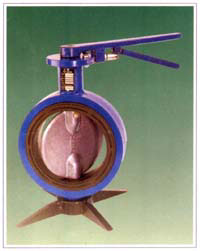Difference between revisions of "Butterfly valve"
(+ cross section) |
|||
| (4 intermediate revisions by 3 users not shown) | |||
| Line 1: | Line 1: | ||
| − | + | [[Image:Wbutterfly.png|frame|Cross-section of butterfly valve; A is barrel, B is seal, C is disk, and D is chamber. Note that sealing geometry is probably inaccurate.]] | |
| + | [[Image:Butterfly_valve.jpg|frame|A typical butterfly valve]] | ||
| + | A '''Butterfly valve''' is a type of flow control device, used to make a fluid start or stop flowing through a section of pipe. The [[valve]] is similar in operation to a [[ball valve]]. A flat circular plate is positioned in the center of the pipe. The plate has a rod through it connected to a handle on the outside of the valve. Rotating the handle turns the plate either parallel or perpendicular to the flow of water, shutting off the flow. It is a very robust and reliable design. However, unlike the ball valve, the plate does not rotate out of the flow of water, so that a [[pressure]] drop is induced in the flow. | ||
| + | |||
| + | These valves are typically used in applications where a very large valve is needed, such as pumpkin chucking and dams, and are available on ebay in sizes from roughly 2" to 10+". These are very cheap, with a 4" metal valve often selling for 50-20$ or less. Unfortunately, most butterfly valves use bolts to attach to the pluming system, requiring one to buy a flanged [[adapter]] or use [[flange]]d metal pipe. | ||
| + | |||
| + | There are three types of butterfly valve: | ||
| + | # '''Resilient butterfly valve''' which has a flexible rubber seat. Working pressure up to 1.6 Mpa (232 psi) | ||
| + | # '''High performance butterfly valve''' which is usually double eccentric in design . Working pressure up to 5.0 Mpa (725 psi) | ||
| + | # '''Tricentric butterfly valve''' which is usually with metal seated design. Working pressure up to 10.0 Mpa (1450 psi) | ||
| + | |||
| + | == See also == | ||
| + | * [[Ball valve]] | ||
| + | * [[Gate valve]] | ||
| + | * [[Globe valve]] | ||
| + | |||
| + | [[category:valves]] | ||
Latest revision as of 22:47, 27 August 2009
A Butterfly valve is a type of flow control device, used to make a fluid start or stop flowing through a section of pipe. The valve is similar in operation to a ball valve. A flat circular plate is positioned in the center of the pipe. The plate has a rod through it connected to a handle on the outside of the valve. Rotating the handle turns the plate either parallel or perpendicular to the flow of water, shutting off the flow. It is a very robust and reliable design. However, unlike the ball valve, the plate does not rotate out of the flow of water, so that a pressure drop is induced in the flow.
These valves are typically used in applications where a very large valve is needed, such as pumpkin chucking and dams, and are available on ebay in sizes from roughly 2" to 10+". These are very cheap, with a 4" metal valve often selling for 50-20$ or less. Unfortunately, most butterfly valves use bolts to attach to the pluming system, requiring one to buy a flanged adapter or use flanged metal pipe.
There are three types of butterfly valve:
- Resilient butterfly valve which has a flexible rubber seat. Working pressure up to 1.6 Mpa (232 psi)
- High performance butterfly valve which is usually double eccentric in design . Working pressure up to 5.0 Mpa (725 psi)
- Tricentric butterfly valve which is usually with metal seated design. Working pressure up to 10.0 Mpa (1450 psi)

